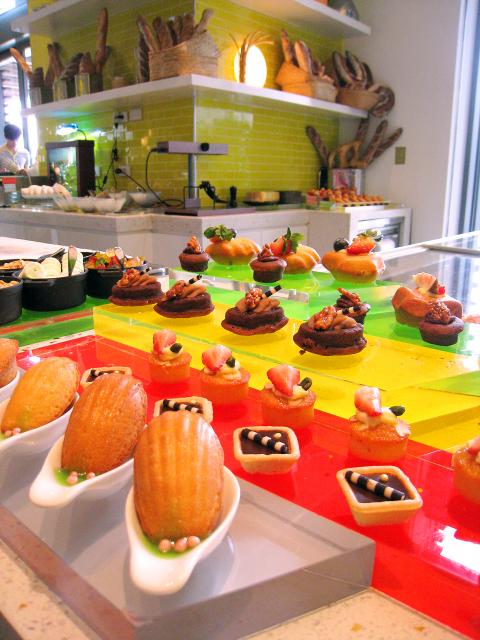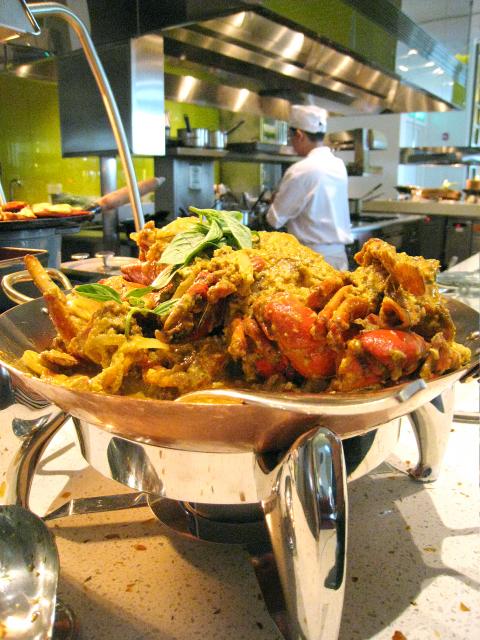Since W Taipei opened in Taipei’s Xinyi District (信義) four months ago, its Kitchen Table restaurant has become a magnet for urbane hipsters. I underestimated the buffet restaurant’s popularity when trying to make a reservation for a Sunday luncheon in May. The reply I got was courteous but disappointing: “We’re sorry, but we are fully booked till August.”
Fortunately, I was able to pull a few strings, and on Sunday I lunched among a herd of champagne-swilling fashionistas, well-attired families and young couples and friends.
The spacious establishment turned out to be an ideal place to while away a Sunday in style. With its French-style windows facing an outdoor swimming pool on one side and a barbecue deck on the other, the restaurant is flooded with sunlight, and its palette of bright yellow and crisp white gives off a summery, buoyant ambiance. The decor glitters with playful designs, such as a ceiling-to-floor partition made of fluorescent green acrylic and a transparent, square-shaped table that can accommodate 10 diners.

Photo: Ho Yi, Taipei Times
Like the design-savvy surroundings, the buffet spread at The Kitchen Table is well-presented in sections including a salad and cold plate area, a hot entree area and a dessert area. I tried the broccoli and chickpea salad, roasted pumpkin with balsamic vinegar and zucchini trifolati with cherry tomatoes, all of which were executed well. The centerpiece of the cold plate section was a large bucket full of king crabs with meat that was satisfyingly fresh and firm.
However, when it came to the selection of hot entrees that included Italian, Cantonese, Indian, Japanese and Thai dishes, my dining partner and I agreed that the food looked better than it tasted. Both the mussels with tomato and cheese and grilled beef fillet with garlic chips were dry, while the lamb shank in red wine stew left a lingering gamy taste in the mouth.
Despite its shortcomings, the Kitchen Table is worth visiting for its creative presentation and diverse choice of food. In particular, the dessert section won my heart with its colorful arrangement of cakes, pies, pastries and a wide selection of ice cream.

Photo: Ho Yi, Taipei Times
Service is professional and friendly. Young chefs are sometimes seen carrying trays filled with samples, inviting diners to try culinary items that haven’t yet made it to the buffet table. The banana chocolate shake I tried was simply a delight, though a chicken skewer was far too chewy.
The Kitchen Table also offers a la carte service from 10am to 10:30pm, featuring light meals such as salads, sandwiches, pizzas and beef noodles. Those who wish to juice up their dining experience at W Taipei can try the selection of wines and cocktails served at Bar at Wet by the swimming pool or the Woobar, which offers piped in lounge music in a chic, cherry-colored setting on the same floor.

May 11 to May 18 The original Taichung Railway Station was long thought to have been completely razed. Opening on May 15, 1905, the one-story wooden structure soon outgrew its purpose and was replaced in 1917 by a grandiose, Western-style station. During construction on the third-generation station in 2017, workers discovered the service pit for the original station’s locomotive depot. A year later, a small wooden building on site was determined by historians to be the first stationmaster’s office, built around 1908. With these findings, the Taichung Railway Station Cultural Park now boasts that it has

The latest Formosa poll released at the end of last month shows confidence in President William Lai (賴清德) plunged 8.1 percent, while satisfaction with the Lai administration fared worse with a drop of 8.5 percent. Those lacking confidence in Lai jumped by 6 percent and dissatisfaction in his administration spiked up 6.7 percent. Confidence in Lai is still strong at 48.6 percent, compared to 43 percent lacking confidence — but this is his worst result overall since he took office. For the first time, dissatisfaction with his administration surpassed satisfaction, 47.3 to 47.1 percent. Though statistically a tie, for most

Wooden houses wedged between concrete, crumbling brick facades with roofs gaping to the sky, and tiled art deco buildings down narrow alleyways: Taichung Central District’s (中區) aging architecture reveals both the allure and reality of the old downtown. From Indigenous settlement to capital under Qing Dynasty rule through to Japanese colonization, Taichung’s Central District holds a long and layered history. The bygone beauty of its streets once earned it the nickname “Little Kyoto.” Since the late eighties, however, the shifting of economic and government centers westward signaled a gradual decline in the area’s evolving fortunes. With the regeneration of the once

In February of this year the Taipei Times reported on the visit of Lienchiang County Commissioner Wang Chung-ming (王忠銘) of the Chinese Nationalist Party (KMT) and a delegation to a lantern festival in Fuzhou’s Mawei District in Fujian Province. “Today, Mawei and Matsu jointly marked the lantern festival,” Wang was quoted as saying, adding that both sides “being of one people,” is a cause for joy. Wang was passing around a common claim of officials of the People’s Republic of China (PRC) and the PRC’s allies and supporters in Taiwan — KMT and the Taiwan People’s Party — and elsewhere: Taiwan and